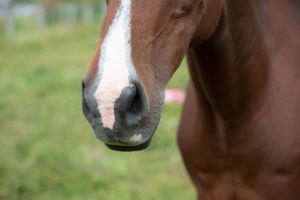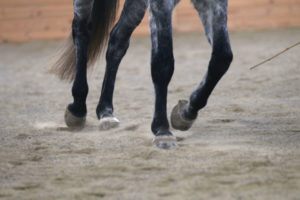Accidents happen. From cuts and scrapes to fever and lameness, a hoof abscess or a puncture wound, being prepared can make all the difference.
With the right supplies, you can treat small problems on your own, and you can be ready to handle emergencies until the vet arrives.
A good first aid kit is essential for every horse owner and in this video, I’ll show you what is in my own barn first aid kit.














33 Responses
Hi Callie,
I smiled when I saw this posting……as I am presently treating my mare for a rope burn on her fetlock joint.( I am very sure now that you could put a horse in a padded room and they would find a way to hurt themselves!)….you have a great collection…I am adding a couple things.
Sooo, I would suggest adding a product called Underwood Horse Medicine to everyone’s collection……I had an ointment on her when the vet arrived which was protecting against infection……He recommended the Underwood. I have not been really impressed with a medication in awhile.( they have a web site with some pretty amazing pics) un believable if I hadn’t known one of them)
I also would suggest….AluSheild Aerosol bandage…. and Wonder Dust for prevention of proud flesh……
Waiting to hear if anyone else has suggestions!….as we all live in different parts of the country and hopefully have great vets.
Leslie
I hope Cita heals quickly from her injury! Thanks for sharing your recommendations
-Julia Burdy, CRK Training Community Manager
Thanks so much for this video Callie! I am looking to purchase my own horse in the coming year and I would like to know about all this information. Do you happen to know of a good book that provides information on how to detect/treat basic ailments?
Hi Annabelle, that is so exciting you are considering purchasing your own horse this year! I would recommend finding a copy of Horse and Pony Ailments by Eddie Straiton, I’ll link it to Amazon if you click here!
-Julia Burdy, CRK Training Community Manager
Hello Kelly
Thank you, I love your videos,
Would you kindly list the items in your first air kid.
What did you say to dilute the iodine with?
Could you show:
Hiw to give a oral medicine.
How to wrap a hoof with dipper.
How to wrap a wound and the leg.
Thank you
Sincerely
Homeira
Hi Homeira, the iodine is just diluted with water! We will include a list here in the post. There are more videos on how to treat first aid situations in our Training Journals program! You can click here to learn more about that program
-Julia Burdy, CRK Training Community Manager
Sugar! Add it to the iodine for sugardine paste. Great to stuff into burst abscesses and other icky bits.
Meds-wise, I always have bute, banamine, dex, and dorm gel.
Needles and syringes, plus a sharps disposal container.
Poultice, both Uptite and Sore-no-more. And by that token, liniment and alcohol.
Electrolytes, Horse Quencher, and Tang (or any other water flavour powder).
A soft plastic bucket for soaking feet.
I strongly suggest bright coloured vetwrap, so if someone manages to remove it, you can easily see it in the field.
I like to have basic farrier tools around to finish pulling a half off shoe.
Samondel, sugar is a great tool for using sugardine – I’ve used to multiple times! The farrier tools are also a great addition!
-Julia Burdy, CRK Training Community Manager
Thanks, Callie. Great list. I would add a stethoscope, Banamine and Bute or other NSAID for pain and inflammation and electrolytes to combat dehydration. Of course, use guidance from the Vet. regarding Banamine and Bute .
Best,
LK
Thank you Lori……have the banamine and bute., but not a stethoscope…..and I think it’s good to have as much info as possible when calling the vet…….leslie
I will video horse on my mobile phone, too, and send to vet.
Audra, mobile phones can certainly come in handy for sending videos to vets!
-Julia Burdy, CRK Training Community Manager
Absolutely! The more details you can give to a vet the better!
-Julia Burdy, CRK Training Community Manager
Thank you very much, Kelly.
This video is very helpful and informative. May I ask you to post the list of first aid kits that you introduced in the video? That will help me check my box.
Oh-I’m going to be a real bummer! While my ‘home base’ is well stocked with anything I might need for emergencies-I do a lot of hauling and mostly trail riding. I have a good first aide kit in the trailer-but have found that most anything “fixable” on the trail can be done with some ingenuity, duct tape, vetrap and a hoof boot…All the shifting back and forth in a saddle pack makes other things wear out, loose their efficacy in the heat of the sun etc…so I do the minimal. Moss and certain duff etc-are good absorbents/padding and the duct tape or vetrap holds it on.
My bummer comment is this…I can’t STAND an animal suffering…We live far away from our vets-They never can arrive in less than an hour and of course in the back country-there aren’t usually any around…That is a long time for a suffering horse to wait to be euthanized.
We always have a ’22 pistol with us. So far-I’ve been fortunate that nobody needed to be euthanized on a trail ride-but yes-at home….six in their 27-37 year range…I love old horses-but I also have a good sense of when enough is enough-poor digestion, chronic founder lameness, severe colic or unforeseen trauma. The most recent one was 37-and he was just “done.” I could see it-he wasn’t keeping his weight. He was isolating and listless.
Everyone (in my book) should know how to do this-I can re-assure you that while it is terribly traumatic for US-So is waiting for the vet to come do “it”. I’ve had two put down by my lovely vets-and it is terrible, long, drawn out, suffocating horrid to comfort them through. Can’t stand it-I forced myself to try a different way-and no longer worry about the food chain being poisoned, or the ground water being affected by a load of drugs, I can usually lead them to where it is convenient to have their bodies-and in one second-it is done.
Every horse I’ve put down with my little 22 pistol has dropped like a stone and never moved except for the normal “twitches”.
You draw an imaginary line between the ear base and the eye and point blank them where there would be the meeting of those two lines as an x. (You can get a picture of this out of “How to Be Your Own Veterinarian Sometimes”. It is NOT between the eyes-but more mid forehead.
This sounds just gruesome-but if I have one of my ancient ones colicking badly, or if I ever had one break it’s leg out on the trail-I breathe deeply-tell them how much I honor their lives and tell them I will end their suffering-and I do. Just in case they fall forward-or something goes wrong-I do not stand directly in front of them-and I remind myself that slow is fast-I owe it to them to do it right.
I know this is a hard one for most people, but it is essential if you are doing any remote riding. The group I rode with in Victoria’s High Country (Australia) always had a gun just in case a horse broke a leg, etc. I couldn’t imagine standing helplessly while my horse suffered needlessly.
I respect you. I don’t live that far away from my vet, but depending on what else is happening with her schedule, I’ve waited several hours. And then the vet procedure was not painless. The needle used caused my horse to jolt even in her pain. So, I do not see vet assisted death as necessarily easier for the horse or anyone who loves the horse.
Hi Claire, thanks for your comment. Especially if you live somewhere that is very remote, it can be an important piece of knowledge that you hope you never have to use.
It is a sad, unfortunate part of horse ownership to have to make difficult calls from time to time and although we don’t like thinking about it preparedness is important
-Julia Burdy, CRK Training Community Manager
I have most of that (will pick up some nonstick bandages on the next run to Target) but also use Alu- spray on small wounds. It doesn’t run off in hot weather, like some of the creams. Of course, it depends on the wound.
I think that the Bute, Alu spray are good suggestions, I also think that neosporin or medihoney are good topicals to add. I prefer trauma shears to regular scissors for their blunt tips, perhaps a sharp pocket knife, #11 exacto or surgical scaple for sharp and pointy. Tweezers can be useful for a multitude of things. I have vet bond as well, though I am not sure this would be considered first aid. Two things to train you and your horse, to take pulse in the two major points without a stethoscope (though very useful for this and digestive diagnosis), and soaking a foot. It can be surprising on how an otherwise well behaved (understanding that this is a rather specious term) horse is difficult to maintain one foot in a bucket of water whether calm or in distress.
The triple antibiotic ointment is a great addition to any kit!
-Julia Burdy, CRK Training Community Manager
a small bag of CLEAN cloths. wash cloth size. Have come in handy on occasion.
A great addition to the first aid kit!
-Julia Burdy, CRK Training Community Manager
Callie – yes, videos showing standard first aid procedures such as putting on standing leg wraps, etc. would be very helpful.
Hi Pam, there are some videos here on the blog to help with first aid procedures but there is a much larger library of those resources in our Training Journals program!
-Julia Burdy, CRK Training Community Manager
Great video! Timely in this quarantine because good preparation can lessen the impact of lack of access. In other words, you may not be able to run to the store right now. Great comments! Hard to delineate between a first aid kit and a medicine kit and a lot depends on your state laws and how remotely you live. I keep everything in an ancient, heavy, four drawer filing cabinet that is mouse proof. Most items in my file are from inexpensive human sources, when possible. In the winter, liquids and creams go in the house so they don’t freeze. There is an empty, five gallon bucket nearby to carry stuff to a stall and a towel to lay out supplies when you get there. Other things in my file include chlorhexidine for wound cleaning and mineral oil for upset stomachs. Bottles of alcohol and peroxide. Needles and syringes sized for the job. Tetnus Antitoxin in case of a large wound. Container for the proper disposal of used syringes. Menstrual pads for use on certain leg wounds. A twitch may be needed for some horses. Large Safety pins. Neck cradle. Plastic wrap or plastic grocery bags. Anti bacterial liquid hand soap and rags for scrubbing wounds. A variety of wound dressings like icthamol, furazone, bag balm, AD ointment, Povidine Iodine ointment, PRID, honey, and horse-specific wound oils and sprays. Colloidal silver liquid. Rescue Remedy, Bell Drops, Haarlem Oil or horse/dog specific essential oils or flower essences. Distilled water, salt, sugar, and apple cider vinegar. Colic herbs and pastes. Medicated powders. Copper sulfate powder, activated charcoal, and iodine crystals. Intensive probiotics in a paste tube. Electrical tape and bandage tape, along with duct tape. Bucket heater. And, depending on your state, over-the-counter and vet prescribed owner-use, at-home meds like Dormagel (tranquilizer), Banamine Paste (colic), Aspirin (pain, inflammation), Benedril (bee stings, snakebites, allergic reactions), Bute (pain and inflammation), Penicillin, and Ulcergard (ulcer colic). A horse first aid and vet book. Notebook and pen. In my area, like mentioned above, it can take awhile to get a vet. So having a .22 rifle in the house and knowing what to do is critical to prevent your friends from suffering, in dire situations.
This is a great list of essentials Marijan, thanks for sharing these recommendations!
-Julia Burdy, CRK Training Community Manager
Such a helpful video thank you. I’ve been working on my first aid kit essentials during quarantine time.
I would like to add: flashlight and headlamp with battery checks every 6 months. If they don’t work they are not useful. Tweezers are on my list. Bandage scissors & small trash bags, notebook pen/pencil also have made my list. Pencil because pen would not work when it’s cold here in middle of winter.
Great additions to the kit Heather!
-Julia Burdy, CRK Training Community Manager
We include triple antibiotic ointment, stethoscope, bottle of water, Bute, and electrolyte paste in ours. We travel and camp with our horses, so the biggest problem is what to keep it all in! We have a separate kit for people, too!
Electrolyte paste is a good idea, especially with traveling and long-distance riding!
-Julia Burdy, CRK Training Community Manager
Hi Callie,
Great video, thank you. Like another person said, I’d love to see a video of how to:
How to wrap a leg wound
How to give oral meds
How to wrap a hoof with a diaper
Thanks very much!
Hi Susan, we cover these in our Training Journals program You can click here to learn more about the program!
You can click here to learn more about the program!
-Julia Burdy, CRK Training Community Manager